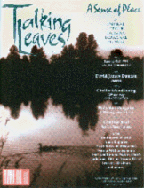

It has been 37 years since the publication of Rachel Carson's Silent Spring. The alert was sounded, some progress made in protecting bird populations from the effects of pesticides, particularly in bringing back from the brink of extinction birds like the peregrine falcon and brown pelican. Yet, where I live, in the Outer Mission district, San Francisco, a paved over, hardened urban neighborhood, the bird habitat of trees, both lining the streets and growing in back yards, is a rarity. My only relief against the deadening landscape is a five-minute walk to a 318-acre urban park, McLaren Park, still largely undeveloped for human recreation in a section of the peninsula swept by scathing, fog-laden winds from the Pacific. There, red-shouldered hawks still screech in mid-air while performing aerodynamic displays of agility; ravens croak while soaring black-figured against leaden skies; and white-crowned sparrows flit about about in dense coyote brush, trilling to each other in their characteristic, melodic song.
Curious about my newly discovered, feathered neighborhood resident, I learned from
Early last fall, during one of those last, warm, clear Indian summer days here in San Francisco before the fog-bound chill of approaching winter begins to roll in, I heard the mockingbird trilling from a rooftop peak across a neighbor's backyard. I noticed that the object of his call was a smaller mockingbird, whom the larger bird was pursuing by diving and hopping rooftop to rooftop, as if in springtime courtship. Finding it hard to believe that two birds would be courting this time of year in preparation for mating and nesting, I did some research and determined the more likely explanation: the larger, more mature male bird was claiming his territory in a time of dwindling fruit supply. His active pursuit also demonstrated another chief mockingbird characteristic--its gymnastic talents. During mating season I've noticed the bird catapulting in air from its perch, as if to do flips, dramatically exhibiting to prospective mates his superior genetic material. The mockingbird's vocal dexterity matches its physical. Field studies record that the mockingbird is capable of imitating over two dozen individual bird songs or calls within a ten-minute span. Computer analyses of this range of mimicry, furthermore, are unable to detect differences from the original sounds.
On a clear moonlit night late last spring, while I lay sleeping, I seemed to dream I heard the mockingbird's song. Slowly awakening, I realized it was really the mockingbird singing in the distance. I did not envy my neighbor somewhere down the block, whose window perhaps opened up directly onto the mockingbird's perch. From where I lay half asleep, however, the bird's warbling evoked mystery. My cottage garden had been turned into a moon-bathed landscape, a paradise filled with the romance of many songbirds calling to each other.
Despite Rachel Carson's clarion call nearly forty years ago, the burgeoning course of human population sprawl since the publication of Silent Spring has diminished much of songbird habitat, impoverishing in turn our aesthetic and emotional wellbeing. Yet life is ever tenacious and adaptable, as demonstrated by species like the mockingbird, who teaches that birdsong will always hold a cherished place among earth sounds. Although its voice is solitary and certainly precarious in this age of diminishing biodiversity, the mockingbird sings to remind us not only of what we have lost individually in songbirds, but also what we still possess collectively as a fellow species, an appreciation of nature's gift of birdsong.:
David Graves, reared in Texas where the mockingbird is the state bird, leads school children and their teachers into San Francisco urban parks to study biodiversity and restore natural areas. When not in the parks with kids, he teaches deep ecology at the university level.
�1999 Talking Leaves We welcome your letters!
For a sample copy of the Summer/Fall 1999 issue, "A Sense of Place," send $6 to
Summer/Fall 1999
Volume 9, Number 2
A Sense of Place
![]()
81868 Lost Valley Lane
Dexter, OR 97431
[email protected]
